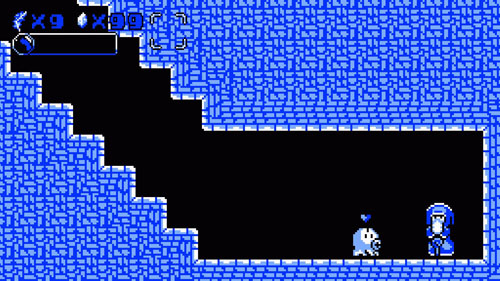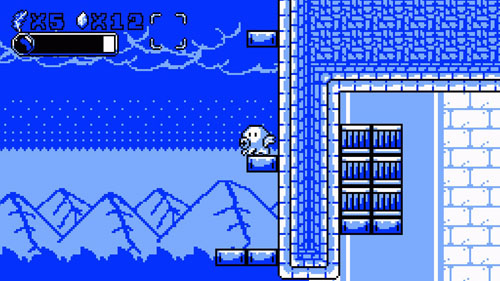A game by Christophe Galati for PC and Switch, originally released in 2018, with the Definitive Edition released in 2021.
Long ago, wise and peaceful octopuses were Earth’s dominant species, but that ended with the rise of humanity, who hunted the cephalopods for food. Eventually, one octopus rose up and formed an army to rid the world of humankind. In Save me Mr Tako: Tasukete Tako-San you take on the role of a plucky octopus named Tako-san (Mr. Tako). Tako-san’s brother (Bako) is a hero of the octopus army, and Tako-san is pulled into the war against the humans, but during his first battle, the army overtakes a human vessel and tosses their princess into the water… and Tako-san casts off his armor and dives in to save her, putting him at odds with his own kind.The game is designed to look like a Game Boy title, with several classic references – including a few nods to the Kirby series in particular – with the game’s cutesy animations, a star that pops out when you land from a high jump, and a character who dons a sleeping cap and dozes off during his idle animation. Players can also stop and press DOWN to scroll the screen downward and get a better view of their surroundings, as was done in a number of classic Game Boy titles due to the limited screen resolution.
The entire game rendered in only four colors, with the world constructed in 16x16 tiles. However, the player isn’t stuck looking at the default sickly green shade for the entire game; just like playing a Game Boy cart on the Game Boy Color, the player can choose from an array of color palettes to suit his aesthetic tastes. The player also doesn’t have to contend with the Game Boy system’s infamous motion blur, but rather gets to experience crisp visuals, a widescreen presentation, and a distinct lack of flicker or slowdown. The game is accompanied by a chiptune soundtrack with more than 100 tracks. The Definitive Edition includes a music player, new difficulty modes, and rebalanced levels, and a hint system.
Tako-san begins the game with an extremely high variable jump, the ability to scramble up onto ledges, and a melee weapon in the form of a spear that juts out slowly. This weapon is eventually replaced by the ability to spit balls of ink over a long distance, and holding the button lets off a rapid fire burst. Later, the player finds hats that grant new types of attacks (more on this in a bit). Each time the player attacks, a stamina meter drains, and once the meter drains completely, the player cannot attack again until it refills. However, the meter only refills itself slightly; players must collect ink pickups to restore it further.
For the most part, the player isn’t in danger of draining the meter, so long as he only attacks when confronted by enemies, but he can also hop on enemies to stun them if he gets in a bind. The ink meter is refilled at the end of each stage, or upon respawning. This restriction keeps the player from simply holding the ATTACK button for the entire game to unleash wanton destruction… or at least wanton stuns.
Enemies aren’t killed when they are attacked, even with weapons like swords; instead, they are covered in ink and stunned for several seconds before returning to normal. Stunned enemies, particularly those that fly, can be used as platforms to reach higher areas, and the player can push stunned enemies around to use them as stepping stones, or just shove them off a cliff to get them out of the way (but they respawn when you leave the screen and return). However, there are certain enemies that react differently to being attacked, such as shielded soldiers who can only be inked from behind, porcupines that cast off your ink very quickly, and ghostly creatures that are impervious to your attacks.
The player begins the game with three lives, and there are few 1UPs – in the form of kelp – spread around the levels in out-of-the-way places. By collecting gems of various denominations, players build up a meter, and each time the meter reaches 100, the player is awarded with an extra life, for a maximum of nine lives at a time. Gems are found by breaking pots and moving off the beaten path to explore, but once the player has nine lives and 99 gems, there is no benefit in collecting them.
The game is extraordinarily easy in the early going, despite the fact that Tako-san dies in a single hit. However the game gets considerably more difficult after the opening areas, offering spike traps, lots of bottomless pits, and invincible enemies that pop up and dash toward the player. Boss battles in particular can be quite difficult given the boss’ speed and maneuverability in comparison to Tako-san.
Damage dealt to bosses carries over when respawning, allowing the player to wage a war of attrition, but once all of his lives are lost, he is booted out of the level to try again, with his life count dropped back to three. The player then has to replay the entire level leading up to the boss - including the unskippable cutscenes - and then try harder not to be defeated and sent back to repeat the process once more.
The player is able to select levels by moving around a hub area and entering doors, with a new door showing up on the map each time a level is completed. The player is free to re-enter any previous level, but for the most part, levels are tackled in order. Levels tend to have a direct path from one end to the other, with a few side paths to find gems, 1UPs, or ink refills, but there are also side paths that lead to NPC’s in need of rescue, as well as some paths that are inaccessible with your default abilities.
There are several levels where you must travel down alternate routes to activate switches and then double back to access the newly-opened doorways, or hop onto newly-generated platforms. There are also forced scrolling levels where the player must keep up with the movement of the screen while dealing with enemies and completing platforming challenges.
Completing a level without finding everything causes a checkmark to appear over the door in the hub area, whereas full completion displays a star. There are also some doorways that lead to villages or other friendly areas where you are free to wander around and speak with NPC’s, many of whom ask you to find family members who have disappeared (although there is no indicator that any given NPC needs to be revisited after rescuing these family members).
Most towns also feature an area where you can play a minigame, and there are numerous minigames to be found across the course of your adventure. These minigames focus on completing short time-limited challenges for the best score. For instance, the player may be asked to stun as many enemies as possible as they spawn into a confined area, or run around a kitchen trying to cook a bunch of food without burning it, or take on a skilled fighter in one-on-one combat. Getting a moderate score rewards the player with a gem, but getting a high score rewards the player with a new hat.
Most hats are entirely optional, and some are just silly, but a number of them can give you a leg up on your journey, and there are 50 hats to be found throughout the game. Most hats offer new weapon types, including bouncing projectiles, arrows, melee weapons, and even the ability to toss crabs... but some are considerably less useful in combat, such as one hat that gives you the ability to grow flowers while you walk. All weapons operate similarly to the ink spray, insofar as they offer rapid-fire attacks and temporarily stun enemies, but most are no more useful than your default weapon, so unless you need to complete a very specific challenge, there isn’t much reason to use them.
That is not to say that hats serve no purpose... There is a hat that lets you absorb an extra hit of damage, which effectively doubles your chances of survival, and you get this one pretty early in the game. Later, you can pick up a crown that lets you take two hits. There’s also an umbrella that protects you from enemies that drop down from the ceiling, and a feather that doubles your movement speed, letting you rip through the levels… at least until you take damage and lose it.
The player is able to wear one hat and carry a backup hat that can be swapped at any time (but the original hat is lost). Hats may be selected from an NPC who appears in each world. Also, larger levels have checkpoints that let the player select a new hat, allowing him to change strategies or simply restore one that he lost during the level. This is also helpful when respawning, as the player can select a hat before jumping back into the fray.
The game is very large for a platformer, offering dozens of levels across six worlds, and numerous dungeons. There’s also quite a lot to the narrative, which delves into the history of humans and octopuses and the current conflict as the octopus army continues on its quest to wipe out humanity at any cost. The player meets up with a number of characters along his journey, some of whom offer to help, and the player often takes control of these characters for a level or two, forcing him to contend with their generally limited (or nonexistent) ability to attack enemies.
Despite the simple core mechanics, there is still a fair amount of gameplay variety between the different hats, occasional new playable characters, and speed-focused levels intermixed with those that center around puzzle solving. Still, there are some niggling issues that impede the experience, such as occasionally getting hung up on scenery when jumping. There’s also a strange issue that prevents you from entering a doorway if you’re standing directly in front of it – which runs counter to the design of most classic games – and you can’t speak to the same NPC twice without moving your character between interactions.
The biggest issue that impacts gameplay is the fact that the action does not pause when the camera scrolls away. So, if you press a switch, the camera will scroll over to show you what changed in the environment. However, you retain full control over your character during this time, despite the fact that he is generally not visible on the screen, which means that you could walk into danger or fall into a bottomless pit. More importantly, enemies continue moving as well. If you stunned an enemy and then pressed the switch, the stun will wear off before the camera scrolls back and the enemy will attack you.
2D CRED
Save me Mr Tako: Tasukete Tako-San was developed by Christophe Galati, based in the south of France. Music and sound for the game were composed by Marc-Antoine Archier, who also hails from France. The game began its life as a prototype that was originally released in 2014 to celebrate the 25th anniversary of the Game Boy. Over the course of the next four years, it was greatly expanded and received a commercial release in 2018.
The game was published by Nicalis, which also published Cave Story+, La-Mulana, 1001 Spikes, The Binding of Isaac: Rebirth, Castle in the Darkness, and the console versions of VVVVVV, among others.
































0 comments:
Post a Comment